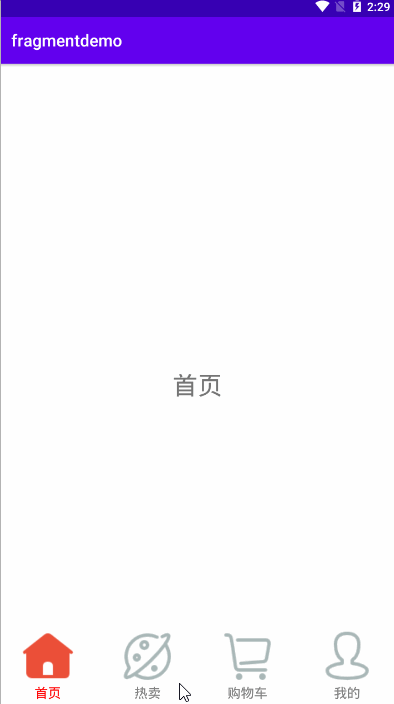小编给大家分享一下Android中如何使用RadioGroup和Fragment实现底部导航栏的功能,相信大部分人都还不怎么了解,因此分享这篇文章给大家参考一下,希望大家阅读完这篇文章后大有收获,下面让我们一起去了解一下吧!在一些购物商城中
小编给大家分享一下Android中如何使用RadioGroup和Fragment实现底部导航栏的功能,相信大部分人都还不怎么了解,因此分享这篇文章给大家参考一下,希望大家阅读完这篇文章后大有收获,下面让我们一起去了解一下吧!
在一些购物商城中经常会遇到这类效果,效果图如下:
先看效果图

步骤一:
完成对主界面main.xml的创建:
<?xml version="1.0" encoding="utf-8"?><RelativeLayout xmlns:android="Http://schemas.android.com/apk/res/android" xmlns:app="http://schemas.android.com/apk/res-auto" xmlns:tools="http://schemas.android.com/tools" android:layout_width="match_parent" android:layout_height="match_parent" tools:context=".MainActivity"> <FrameLayout android:id="@+id/fragment_layout" android:layout_width="match_parent" android:layout_height="match_parent" android:layout_alignParentTop="true" /> <RadioGroup android:layout_width="match_parent" android:layout_height="wrap_content" android:id="@+id/rg_group" android:layout_alignParentBottom="true" android:orientation="horizontal" > <RadioButton android:id="@+id/rb_home" android:layout_width="0dp" android:layout_height="match_parent" android:layout_weight="1" android:button="@null" android:drawableTop="@drawable/rb_home_selector" android:text="首页" /> <RadioButton android:id="@+id/rb_discover" android:layout_width="0dp" android:layout_height="match_parent" android:layout_weight="1" android:button="@null" android:drawableTop="@drawable/rb_discover_selector" android:text="热卖" /> <RadioButton android:id="@+id/rb_cart" android:layout_width="0dp" android:layout_height="match_parent" android:layout_weight="1" android:button="@null" android:drawableTop="@drawable/rb_cart_selector" android:text="购物车" /> <RadioButton android:id="@+id/rb_user" android:layout_width="0dp" android:layout_height="match_parent" android:layout_weight="1" android:button="@null" android:drawableTop="@drawable/rb_user_selector" android:text="我的" /> </RadioGroup></RelativeLayout>radioButton中重复使用的样式:被抽取出来在style中写出
<style name="fragment"> <item name="android:layout_width">match_parent</item> <item name="android:layout_height">match_parent</item> <item name="android:padding">5dp</item> <item name="android:gravity">center</item> <item name="android:textColor">@drawable/rb_text_color</item> <item name="android:textSize">16sp</item> <item name="android:textStyle">nORMal</item> </style>点击RadioButton之后,导航栏文字颜色发生改变,声明在drawable中
名字为:rb_text_color代码如下:
<?xml version="1.0" encoding="utf-8"?><selector xmlns:android="http://schemas.android.com/apk/res/android"> <item android:state_selected="true" android:color="#FF0000"/> <item android:color="#808080"/></selector>导航栏图标发生变化这里只写其中一个其他三个都基本一样:
<?xml version="1.0" encoding="utf-8"?><selector xmlns:android="http://schemas.android.com/apk/res/android"> <item android:drawable="@drawable/icon_cartfill_press" android:state_selected="true" /> <item android:drawable="@drawable/icon_cart" /></selector>完成这些基本步骤之后,接下来就需要写Fragment的布局
<?xml version="1.0" encoding="utf-8"?><LinearLayout xmlns:android="http://schemas.android.com/apk/res/android" android:layout_width="match_parent" android:layout_height="match_parent" android:gravity="center"> <TextView android:id="@+id/tv_cart" android:layout_width="wrap_content" android:layout_height="wrap_content" android:text="购物车" android:textSize="30sp" /></LinearLayout>写出其中一个另外三个类似。
之后后台代码中创建Fragment,这里也写其中一个:CartFragment
package com.example.fragmentdemo;import android.os.Bundle;import android.view.LayoutInflater;import android.view.View;import android.view.ViewGroup;import android.widget.TextView;import androidx.annotation.NonNull;import androidx.annotation.Nullable;import androidx.fragment.app.Fragment;public class CartFragment extends Fragment { private View view; private TextView tv_home; @Nullable @Override public View onCreateView(@NonNull LayoutInflater inflater, @Nullable ViewGroup container, @Nullable Bundle savedInstanceState) { if (view==null){ view = inflater.inflate(R.layout.cart_fragment,container,false); } return view; }}步骤二:在MainActivity中,完成对fragment的切换功能
具体注释已在代码中给出。
package com.example.fragmentdemo;import androidx.appcompat.app.AppCompatActivity;import androidx.fragment.app.Fragment;import androidx.fragment.app.FragmentManager;import androidx.fragment.app.FragmentTransaction;import android.os.Bundle;import android.util.Log;import android.view.View;import android.widget.RadioButton;import android.widget.RadioGroup;import java.time.LocalDate;import java.util.ArrayList;import java.util.List;public class MainActivity extends AppCompatActivity implements RadioGroup.OnCheckedChangeListener { private RadioButton rb_home,rb_discover,rb_cart,rb_user; private RadioGroup rg_group; private List<Fragment> fragments; private int position=0; private static final String TAG = "MainActivity"; @Override protected void onCreate(Bundle savedInstanceState) { super.onCreate(savedInstanceState); setContentView(R.layout.activity_main); rb_home=findViewById(R.id.rb_home); rb_discover=findViewById(R.id.rb_discover); rb_cart=findViewById(R.id.rb_cart); rb_user=findViewById(R.id.rb_user); rg_group=findViewById(R.id.rg_group); //默认选中第一个 rb_home.setSelected(true); rg_group.setOnCheckedChangeListener(this); //初始化fragment initFragment(); //默认布局,选第一个 defaultFragment(); } private void defaultFragment() { FragmentManager fragmentManager = getSupportFragmentManager(); FragmentTransaction transaction = fragmentManager.beginTransaction(); transaction.replace(R.id.fragment_layout,fragments.get(0)); transaction.commit(); } private void setSelected() { rb_home.setSelected(false); rb_discover.setSelected(false); rb_cart.setSelected(false); rb_user.setSelected(false); } private void initFragment() { fragments = new ArrayList<>(); fragments.add(0,new HomeFragment()); fragments.add(1,new DiscoverFragment()); fragments.add(2,new CartFragment()); fragments.add(3,new UserFragment()); } @Override public void onCheckedChanged(RadioGroup group, int i) { //获取fragment管理类对象 FragmentManager fragmentManager = getSupportFragmentManager(); //拿到fragmentManager的触发器 FragmentTransaction transaction = fragmentManager.beginTransaction(); switch (i){ case R.id.rb_home: position=0; //调用replace方法,将fragment,替换到fragment_layout这个id所在UI,或者这个控件上面来 //这是创建replace这个事件,如果想要这个事件执行,需要把这个事件提交给触发器 //用commit()方法 transaction.replace(R.id.fragment_layout,fragments.get(0)); //将所有导航栏设成默认色 setSelected(); rb_home.setSelected(true); break; case R.id.rb_discover: position=1; transaction.replace(R.id.fragment_layout,fragments.get(1)); //将所有导航栏设成默认色 setSelected(); rb_discover.setSelected(true); break; case R.id.rb_cart: position=2; transaction.replace(R.id.fragment_layout,fragments.get(2)); //将所有导航栏设成默认色 setSelected(); rb_cart.setSelected(true); break; case R.id.rb_user: position=3; transaction.replace(R.id.fragment_layout,fragments.get(3)); //将所有导航栏设成默认色 setSelected(); rb_user.setSelected(true); break; } //事件的提交 transaction.commit(); }}这样就完成了一个简单的底部导航栏功能,这个只能通过点击切换fragment,不能通过左右滑动去切换fragment。
以上是“Android中如何使用RadioGroup和Fragment实现底部导航栏的功能”这篇文章的所有内容,感谢各位的阅读!相信大家都有了一定的了解,希望分享的内容对大家有所帮助,如果还想学习更多知识,欢迎关注编程网精选频道!
--结束END--
本文标题: Android中如何使用RadioGroup和Fragment实现底部导航栏的功能
本文链接: https://www.lsjlt.com/news/279708.html(转载时请注明来源链接)
有问题或投稿请发送至: 邮箱/279061341@qq.com QQ/279061341
下载Word文档到电脑,方便收藏和打印~
2024-05-02
2024-05-02
2024-05-02
2024-05-02
2024-05-02
2024-05-02
2024-05-02
2024-05-02
2024-05-02
2024-05-02
回答
回答
回答
回答
回答
回答
回答
回答
回答
回答
0